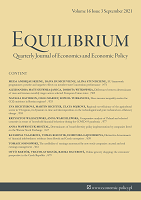Comparison of changes in the labour markets of post-communist countries with other EU member states
Comparison of changes in the labour markets of post-communist countries with other EU member states
Author(s): Krzysztof Dmytrów, Beata Bieszk-StolorzSubject(s): Labor relations, Post-Communist Transformation, EU-Approach / EU-Accession / EU-Development
Published by: Instytut Badań Gospodarczych
Keywords: European labour market; linear ordering; Dynamic Time Warping; Ward’s method; cluster analysis;
Summary/Abstract: Research background: Since 2004, 11 post-communist countries joined the EU. It has helped to strengthen their international competitiveness. This was linked to the implementation of institutional and economic reforms, significant technological changes and improvements in the quality of human capital, as well as fiscal stabilisation policies. These changes affected their situation in the labour market. Purpose of the article: The aim of the study is to assess changes in the situation in the labour market in the EU with particular emphasis on the post-communist countries in the period 2002? 2019. Methods: The situation of countries in the European labour market was estimated using the TOPSIS method. A similarity matrix of changes in the composite variable for each country was then constructed using the Dynamic Time Warping method. On its basis, homogeneous clusters of countries were determined using the Ward?s method. Findings & value added: Four homogenous clusters of countries were formed. The post-communist ones belonged to two groups. In one, there were two countries ? Croatia and Slovakia. The rest of the post-communist countries were in a large cluster, which also included Germany, Malta, Finland, Portugal, France and Belgium. Changes of the situation in the post-communist countries in this group improved very much during the analysed period (this was particularly evident for Czechia, Estonia and Poland). It is interesting to investigate whether the reaction of labour markets to changes in the global economic situation in post-communist countries is similar to that in the old EU countries. The similarity of changes can be measured using the DTW method. There is an empirical research gap in this respect. Therefore, the added value is the use of this method in assessing similarities of changes in the labour market situation in post-communist countries in comparison to the Western European ones.
Journal: Equilibrium. Quarterly Journal of Economics and Economic Policy
- Issue Year: 16/2021
- Issue No: 4
- Page Range: 741-764
- Page Count: 24
- Language: English

